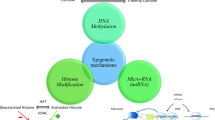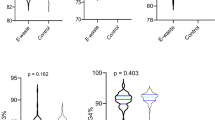Abstract
Background
Occupational and environmental exposure to lead (Pb) is a persistent health problem majorly in developing countries and has been implied to cause epigenetic alterations. Its effect on histone post-translational modifications is not explored in human population. MicroRNAs are epigenetic modulators reported to be differentially expressed under Pb exposure. The present study was targeted to find plausible association between the role of hsa-miR-146a and global histone (H3) acetylation in Pb-induced inflammation in occupationally exposed workers.
Materials and methods
A total of 100 occupationally exposed individuals working in different industries were recruited for the study and divided into 2 groups based on the median Pb levels [low Pb group (Pb < 5 μg/dL) and High Pb group (Pb > 5 μg/dL)]. The Pb levels were measured in whole blood using atomic absorption spectrometry to confirm Pb exposure. Histone H3 acetylation and serum interleukin-6 (IL-6) levels were measured using colorimetric methods and enzyme-linked immunosorbent assay (ELISA), respectively. MicroRNA-146a expression was quantified using TaqMan assay.
Results
The median BLL of the study population was 5 μg/dL. BLL, IL-6, and Histone (H3) acetylation increased significantly with the duration of exposure. BLL level showed a significant positive correlation with IL-6 and histone H3 acetylation level. We also found that hsa-miR-146a exhibited significantly increased expression in the high Pb group compared to the low Pb group (Fold change: 2.56; P = 0.014). The linear regression model suggested that BLL has significantly predicted histone H3 acetylation, hsa-miR-146a, and IL-6 in the study subjects.
Conclusion
The finding that hsa-miR146a was significantly upregulated in individuals with high BLL and had a significant negative correlation with serum IL-6 suggests that Pb-induced oxidative stress likely activates H3 acetylation, which then releases inflammatory cytokines like IL-6.

Similar content being viewed by others
Data availability
The datasets generated during and/or analysed during the current study are not publicly available because of the ongoing project. But the data are available from the corresponding author on reasonable request.
References
Barnes PJ, Adcock IM, Ito K (2005) Histone acetylation and deacetylation: importance in inflammatory lung diseases. Eur Respir J 25:552–563. https://doi.org/10.1183/09031936.05.00117504
Bhatt K, Lanting LL, Jia Y et al (2016) Anti-Inflammatory role of MicroRNA-146a in the pathogenesis of diabetic nephropathy. J Am Soc Nephrol 27:2277–2288. https://doi.org/10.1681/ASN.2015010111
Bihaqi SW, Huang H, Wu J, Zawia NH (2011) Infant exposure to lead (Pb) and epigenetic modifications in the aging primate brain: implications for Alzheimer’s disease. J Alzheimers Dis JAD 27:819–833. https://doi.org/10.3233/JAD-2011-111013
Bradford MM (1976) A rapid and sensitive method for the quantitation of microgram quantities of protein utilizing the principle of protein-dye binding. Anal Biochem 72:248–254. https://doi.org/10.1006/abio.1976.9999
Choudhury M, Park P-H, Jackson D, Shukla SD (2010) Evidence for the role of oxidative stress in the acetylation of histone H3 by ethanol in rat hepatocytes. Alcohol Fayettev N 44:531–540. https://doi.org/10.1016/j.alcohol.2010.06.003
Chuang JC, Jones PA (2007) Epigenetics and microRNAs. Pediatr Res 61:24R-29R. https://doi.org/10.1203/pdr.0b013e3180457684
Dupont C, Armant DR, Brenner CA (2009) Epigenetics: definition, mechanisms and clinical perspective. Semin Reprod Med 27:351. https://doi.org/10.1055/s-0029-1237423
Dyatlov VA, Lawrence DA (2002) Neonatal lead exposure potentiates sickness behavior induced by Listeria monocytogenes infection of mice. Brain Behav Immun 16:477–492. https://doi.org/10.1006/brbi.2001.0641
Gao J, Wang D, Liu D et al (2015) Tumor necrosis factor-related apoptosis-inducing ligand induces the expression of proinflammatory cytokines in macrophages and re-educates tumor-associated macrophages to an antitumor phenotype. Mol Biol Cell 26:3178–3189. https://doi.org/10.1091/mbc.E15-04-0209
Heo Y, Parsons PJ, Lawrence DA (1996) Lead differentially modifies cytokine production in vitro and in vivo. Toxicol Appl Pharmacol 138:149–157. https://doi.org/10.1006/taap.1996.0108
Hu L, Yu Y, Huang H et al (2017) Epigenetic regulation of interleukin 6 by histone acetylation in macrophages and its role in paraquat-induced pulmonary fibrosis. Front Immunol 7:696. https://doi.org/10.3389/fimmu.2016.00696
Jiang S, Hu Y, Deng S et al (2018) miR-146a regulates inflammatory cytokine production in Porphyromonas gingivalis lipopolysaccharide-stimulated B cells by targeting IRAK1 but not TRAF6. Biochim Biophys Acta Mol Basis Dis 1864:925–933. https://doi.org/10.1016/j.bbadis.2017.12.035
Kasperczyk S, Słowińska-Łożyńska L, Kasperczyk A et al (2015) The effect of occupational lead exposure on lipid peroxidation, protein carbonylation, and plasma viscosity. Toxicol Ind Health 31:1165–1171. https://doi.org/10.1177/0748233713491804
Khan DA, Qayyum S, Saleem S, Khan FA (2008) Lead-induced oxidative stress adversely affects health of the occupational workers. Toxicol Ind Health 24:611–618. https://doi.org/10.1177/0748233708098127
Kietzmann T, Petry A, Shvetsova A et al (2017) The epigenetic landscape related to reactive oxygen species formation in the cardiovascular system. Br J Pharmacol 174:1533–1554. https://doi.org/10.1111/bph.13792
Kishikawa H, Lawrence DA (1998) Differential production of interleukin-6 in the brain and spleen of mice treated with lipopolysaccharide in the presence and absence of lead. J Toxicol Environ Health A 53:357–373. https://doi.org/10.1080/009841098159222
Lambert KA, Roff AN, Panganiban RP et al (2018) MicroRNA-146a is induced by inflammatory stimuli in airway epithelial cells and augments the anti-inflammatory effects of glucocorticoids. Plos one 13:e0205434. https://doi.org/10.1371/journal.pone.0205434
Liu C-M, Sun Y-Z, Sun J-M et al (2012) Protective role of quercetin against lead-induced inflammatory response in rat kidney through the ROS-mediated MAPKs and NF-κB pathway. Biochim Biophys Acta 1820:1693–1703. https://doi.org/10.1016/j.bbagen.2012.06.011
Liu T, Zhang L, Joo D, Sun S-C (2017) NF-κB signaling in inflammation. Signal Transduct Target Ther 2:17023. https://doi.org/10.1038/sigtrans.2017.23
Liu W, Wu Y-H, Zhang L et al (2018) MicroRNA-146a suppresses rheumatoid arthritis fibroblast-like synoviocytes proliferation and inflammatory responses by inhibiting the TLR4/NF-kB signaling. Oncotarget 9:23944–23959. https://doi.org/10.18632/oncotarget.24050
Marchlewicz M, Michalska T, Wiszniewska B (2004) Detection of lead-induced oxidative stress in the rat epididymis by chemiluminescence. Chemosphere 57:1553–1562. https://doi.org/10.1016/j.chemosphere.2004.08.102
Martinez-Zamudio R, Ha HC (2011) Environmental epigenetics in metal exposure. Epigenetics 6:820–827. https://doi.org/10.4161/epi.6.7.16250
Mitra P, Misra S, Sharma P (2021) Epigenetics in lead toxicity: new avenues for future research. Indian J Clin Biochem IJCB 36:129–130. https://doi.org/10.1007/s12291-021-00969-y
Moosavi A, Ardekani AM (2016) Role of epigenetics in biology and human diseases. Iran Biomed J 20:246–258. https://doi.org/10.22045/ibj.2016.01
O’Brien J, Hayder H, Zayed Y, Peng C (2018) Overview of MicroRNA biogenesis, mechanisms of actions, and circulation. Front Endocrinol. https://doi.org/10.3389/fendo.2018.00402
Patra RC, Rautray AK, Swarup D (2011) Oxidative stress in lead and cadmium toxicity and its amelioration. Vet Med Int 2011:457327. https://doi.org/10.4061/2011/457327
Pfeiffer D, Roßmanith E, Lang I, Falkenhagen D (2017) miR-146a, miR-146b, and miR-155 increase expression of IL-6 and IL-8 and support HSP10 in an In vitro sepsis model. PloS One 12:e0179850. https://doi.org/10.1371/journal.pone.0179850
Rahman I, Marwick J, Kirkham P (2004) Redox modulation of chromatin remodeling: impact on histone acetylation and deacetylation, NF-kappaB and pro-inflammatory gene expression. Biochem Pharmacol 68:1255–1267. https://doi.org/10.1016/j.bcp.2004.05.042
Ramesh GT, Manna SK, Aggarwal BB, Jadhav AL (2001) Lead exposure activates nuclear factor kappa B, activator protein-1, c-Jun N-terminal kinase and caspases in the rat brain. Toxicol Lett 123:195–207. https://doi.org/10.1016/s0378-4274(01)00395-2
Ryu H-W, Lee DH, Won H-R et al (2015) Influence of toxicologically relevant metals on human epigenetic regulation. Toxicol Res 31:1–9. https://doi.org/10.5487/TR.2015.31.1.001
Saikiran G, Mitra P, Sharma S et al (2021) Selenium, oxidative stress and inflammatory markers in handicraft workers occupationally exposed to lead. Arch Environ Occup Health. https://doi.org/10.1080/19338244.2021.1968780
Sanada T, Sano T, Sotomaru Y et al (2020) Anti-inflammatory effects of miRNA-146a induced in adipose and periodontal tissues. Biochem Biophys Rep 22:100757. https://doi.org/10.1016/j.bbrep.2020.100757
Sundar IK, Nevid MZ, Friedman AE, Rahman I (2014) Cigarette smoke induces distinct chromatin histone modifications in lung cells: implication in pathogenesis of COPD and lung cancer. J Proteome Res 13:982–996. https://doi.org/10.1021/pr400998n
Veerasubramanian PK, Shao H, Meli VS et al (2021) A Src-H3 acetylation signaling axis integrates macrophage mechanosensation with inflammatory response. Biomaterials 279:121236. https://doi.org/10.1016/j.biomaterials.2021.121236
Wada TT, Araki Y, Sato K et al (2014) Aberrant histone acetylation contributes to elevated interleukin-6 production in rheumatoid arthritis synovial fibroblasts. Biochem Biophys Res Commun 444:682–686. https://doi.org/10.1016/j.bbrc.2014.01.195
Wallace DR, Taalab YM, Heinze S et al (2020) Toxic-metal-induced alteration in mirna expression profile as a proposed mechanism for disease development. Cells 9:E901. https://doi.org/10.3390/cells9040901
Wang J, Yang Z, Lin L et al (2012) Protective effect of naringenin against lead-induced oxidative stress in rats. Biol Trace Elem Res 146:354–359. https://doi.org/10.1007/s12011-011-9268-6
Wang JH, Shih KS, Wu YW et al (2013) Histone deacetylase inhibitors increase microRNA-146a expression and enhance negative regulation of interleukin-1β signaling in osteoarthritis fibroblast-like synoviocytes. Osteoarthritis Cartilage 21:1987–1996. https://doi.org/10.1016/j.joca.2013.09.008
Xie Y, Chu A, Feng Y et al (2018) MicroRNA-146a: a comprehensive indicator of inflammation and oxidative stress status induced in the brain of chronic T2DM rats. Front Pharmacol 9:478. https://doi.org/10.3389/fphar.2018.00478
Yan C, Boyd DD (2006) Histone H3 acetylation and H3 K4 methylation define distinct chromatin regions permissive for transgene expression. Mol Cell Biol 26:6357–6371. https://doi.org/10.1128/MCB.00311-06
Yu Y, An X, Fan D (2021) Histone deacetylase sirtuin 2 enhances viability of trophoblasts through p65-mediated MicroRNA-146a/ACKR2 axis. Reprod Sci Thousand Oaks Calif 28:1370–1381. https://doi.org/10.1007/s43032-020-00398-x
Zhou C, Zhao L, Wang K et al (2019) MicroRNA-146a inhibits NF-κB activation and pro-inflammatory cytokine production by regulating IRAK1 expression in THP-1 cells. Exp Ther Med 18:3078–3084. https://doi.org/10.3892/etm.2019.7881
Funding
The authors declare that no funds, grants, or other support were received during the preparation of this manuscript.
Author information
Authors and Affiliations
Contributions
All authors contributed to the study conception and design. Conceptualisation: SKG, SS; material preparation, data collection and analysis: PVSNKK, SS, SKG, TG, PM; manuscript first draft preparation: PVSNKK, KK,: SKG, SR; writing, review and editing: PVSNKK, SS, KK, SR, PS; sample testing:: SKG, SS; Patient recruiting: SS,: SKG; supervision: SS and PS.
Corresponding author
Ethics declarations
Conflict of interest
The authors have no relevant financial or non-financial interests to disclose.
Ethical approval
This study was performed in line with the principles of the Declaration of Helsinki. The present study was approved by the All-India Institute of Medical Sciences, Jodhpur Institutional Ethics Committee. Ethics approval certificate number: AIIMS/IEC/2018/411.
Consent to participate
Informed consent was obtained from all individual participants included in the study. No personal data (name, pictures) of the participants were used study.
Additional information
Publisher's Note
Springer Nature remains neutral with regard to jurisdictional claims in published maps and institutional affiliations.
Supplementary Information
Below is the link to the electronic supplementary material.
Rights and permissions
Springer Nature or its licensor (e.g. a society or other partner) holds exclusive rights to this article under a publishing agreement with the author(s) or other rightsholder(s); author self-archiving of the accepted manuscript version of this article is solely governed by the terms of such publishing agreement and applicable law.
About this article
Cite this article
Kiran, G.S., Kumar, P.K., Mitra, P. et al. Unravelling blood-based epigenetic mechanisms: the impact of hsa-miR-146a and histone H3 acetylation in lead-induced inflammation among occupational workers. Int Arch Occup Environ Health 96, 1257–1266 (2023). https://doi.org/10.1007/s00420-023-02004-4
Received:
Accepted:
Published:
Issue Date:
DOI: https://doi.org/10.1007/s00420-023-02004-4




